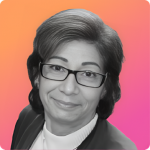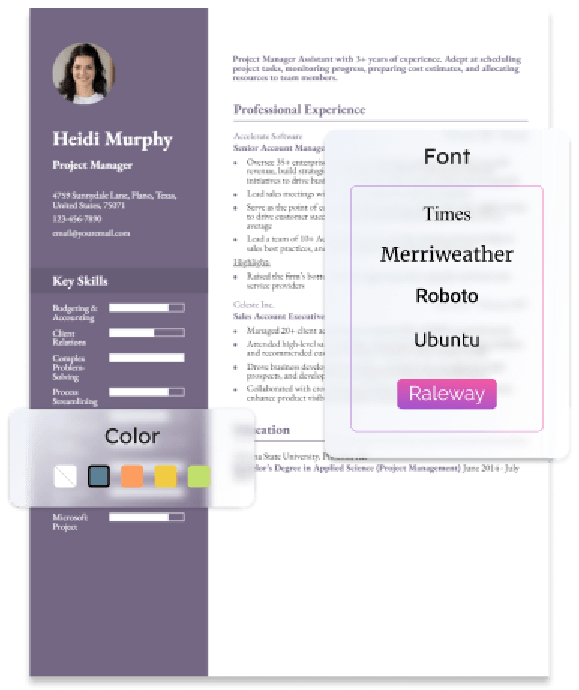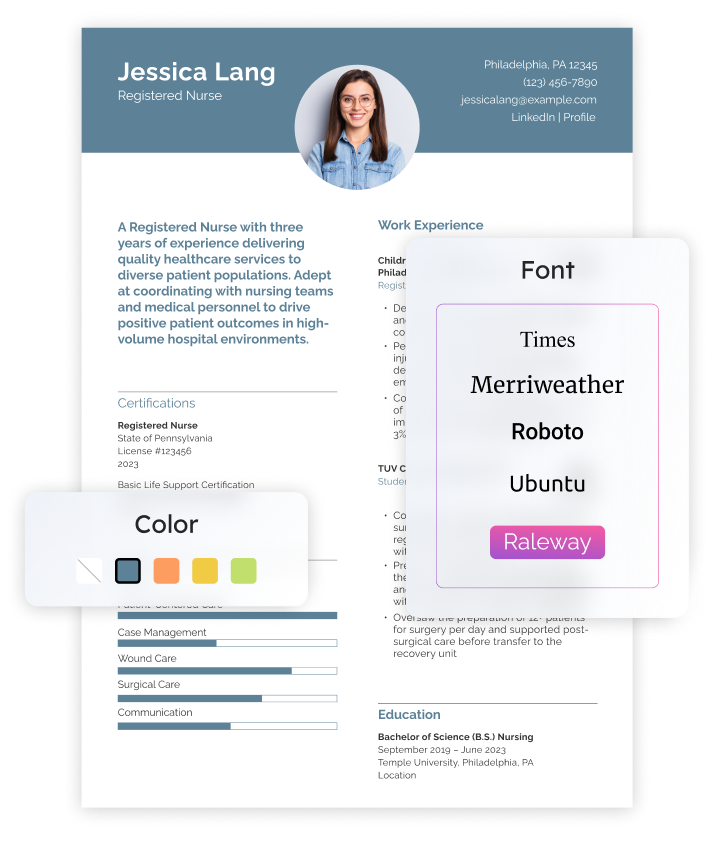As a carpenter, your resume showcases your expertise, experience, and abilities in the construction industry, from cabinetry to woodworking and beyond. This guide provides you with valuable advice and real carpenter resume examples.
You’ll learn the importance of a well-structured resume and how to highlight your carpentry skills, projects, and achievements effectively. Whether you’re an experienced carpenter looking for new opportunities or an apprentice taking your first steps in the industry, this guide will equip you with the knowledge and tools to create a compelling resume that opens doors to new opportunities.
Most Popular Carpenter Resumes
Entry-Level Carpenter Resume
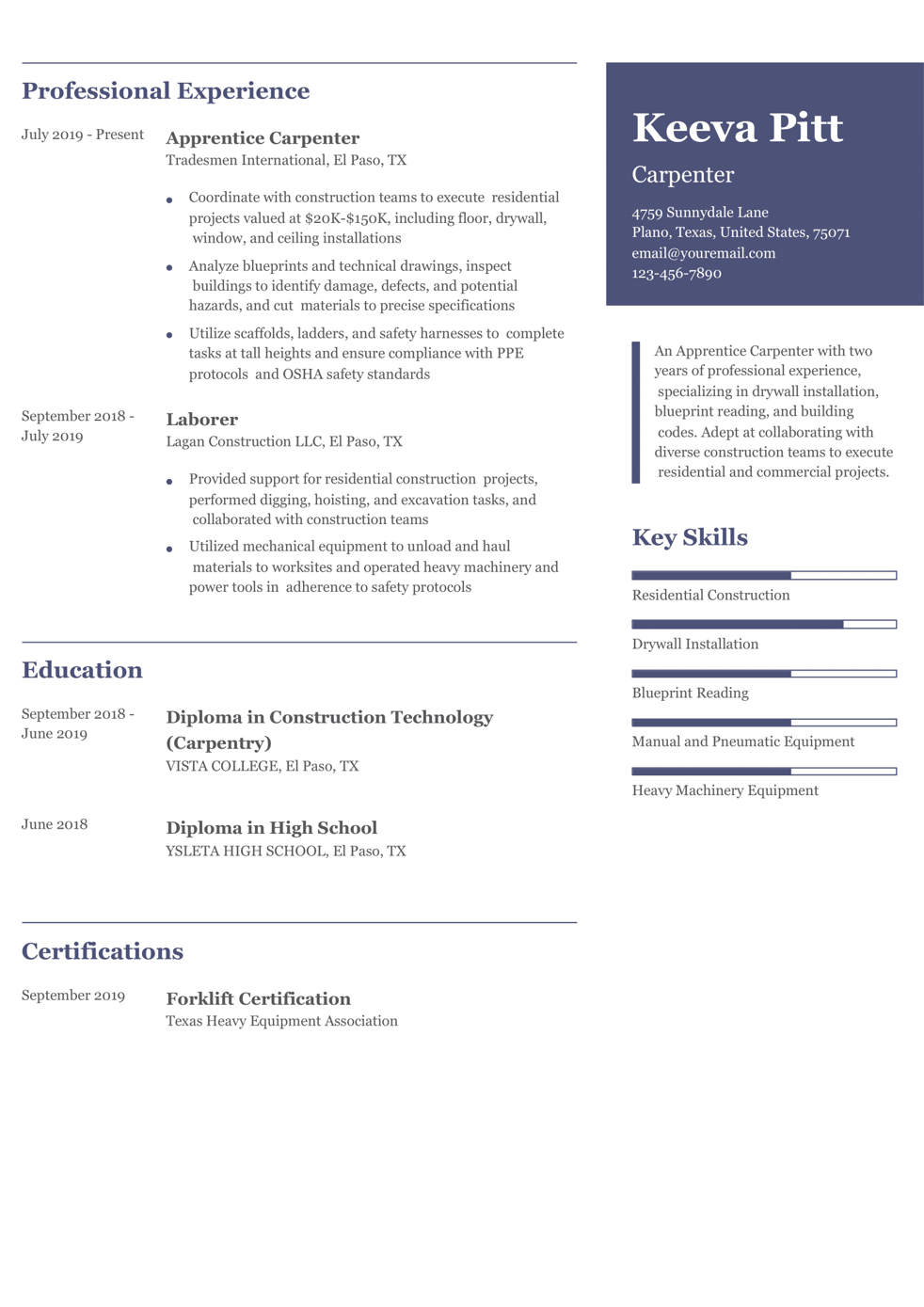
Why This Resume Works
Keeva's resume highlights hands-on experience and formal education, making her a strong candidate for an apprenticeship or entry-level role. It emphasizes key technical skills, such as blueprint reading and drywall installation, and her ability to collaborate on large projects. Learn how to make your resume stand out here.
Journeyman Carpenter Resume
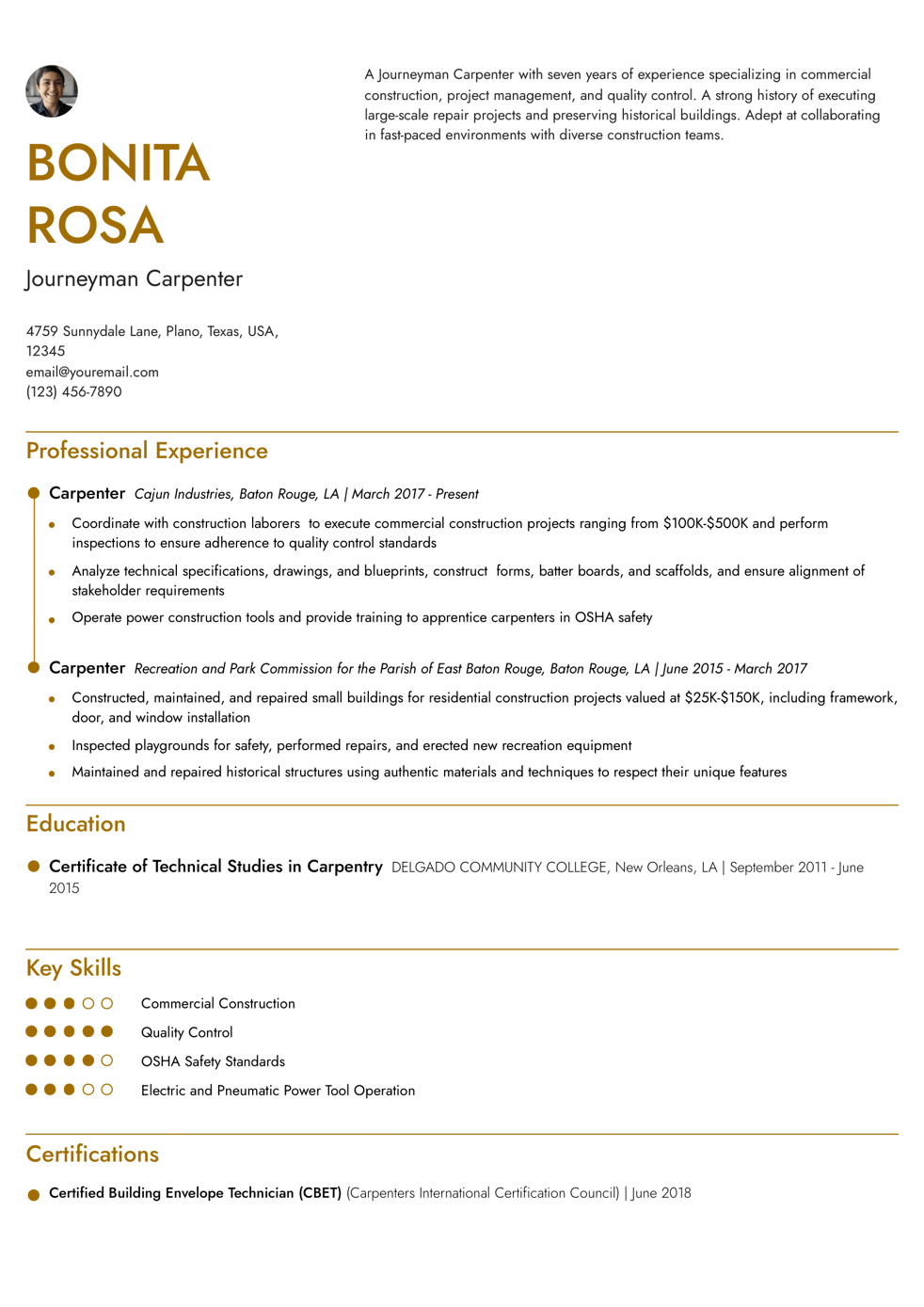
Why This Resume Works
This resume showcases the kind of projects Bonita has worked on, highlighting her safety certifications and leadership abilities. It positions her as a highly skilled journeyman carpenter who can handle complex projects while maintaining quality and safety standards. Learn more about resume skills.
Master Carpenter Resume
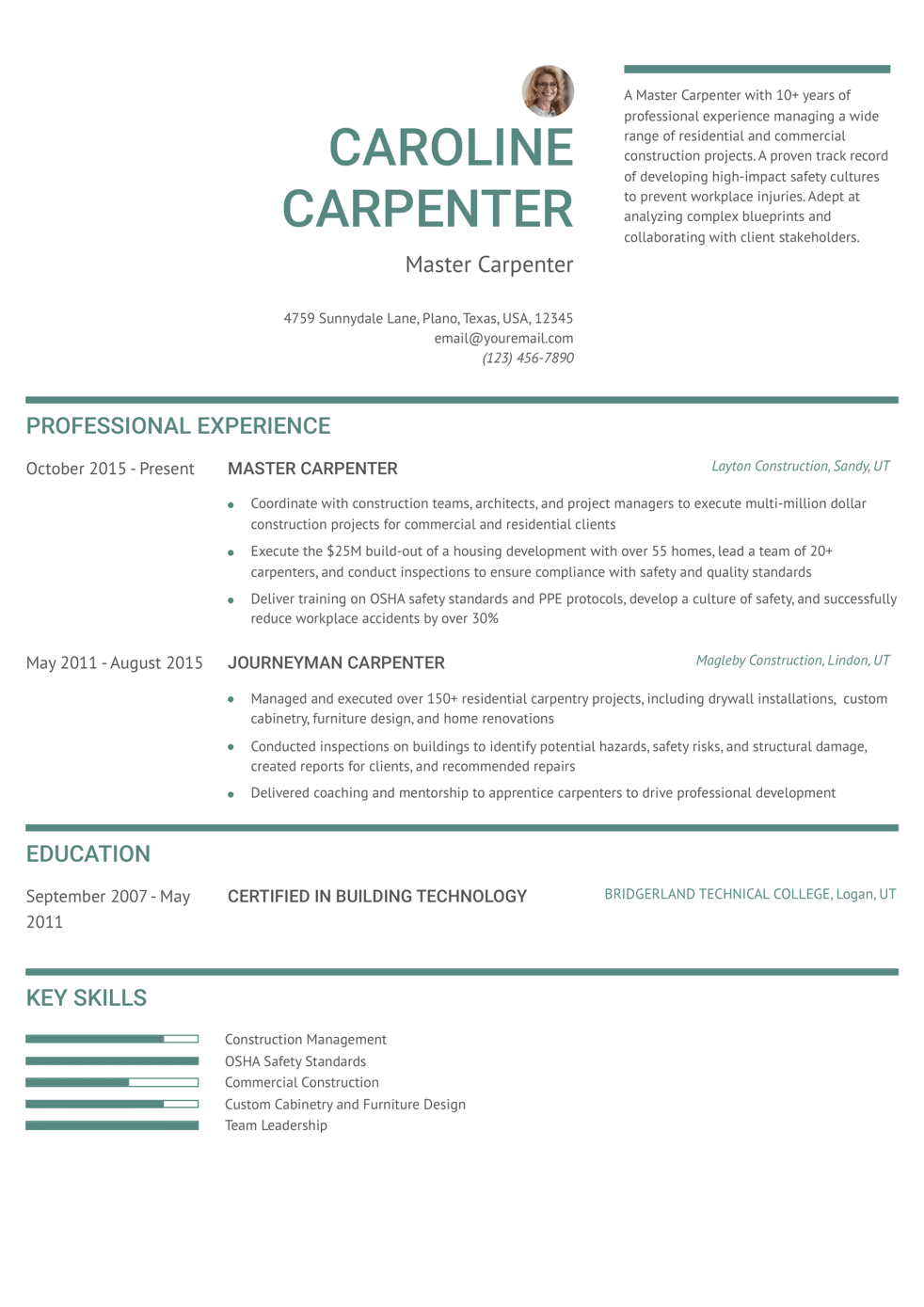
Why This Resume Works
Caroline’s resume stands out for its emphasis on leadership, safety culture, and complex project management. It highlights her proven success in large-scale construction projects, as well as her experience in reducing workplace accidents, which is critical in this field. Learn more about the best resume formats.
Carpenter Assistant Resume
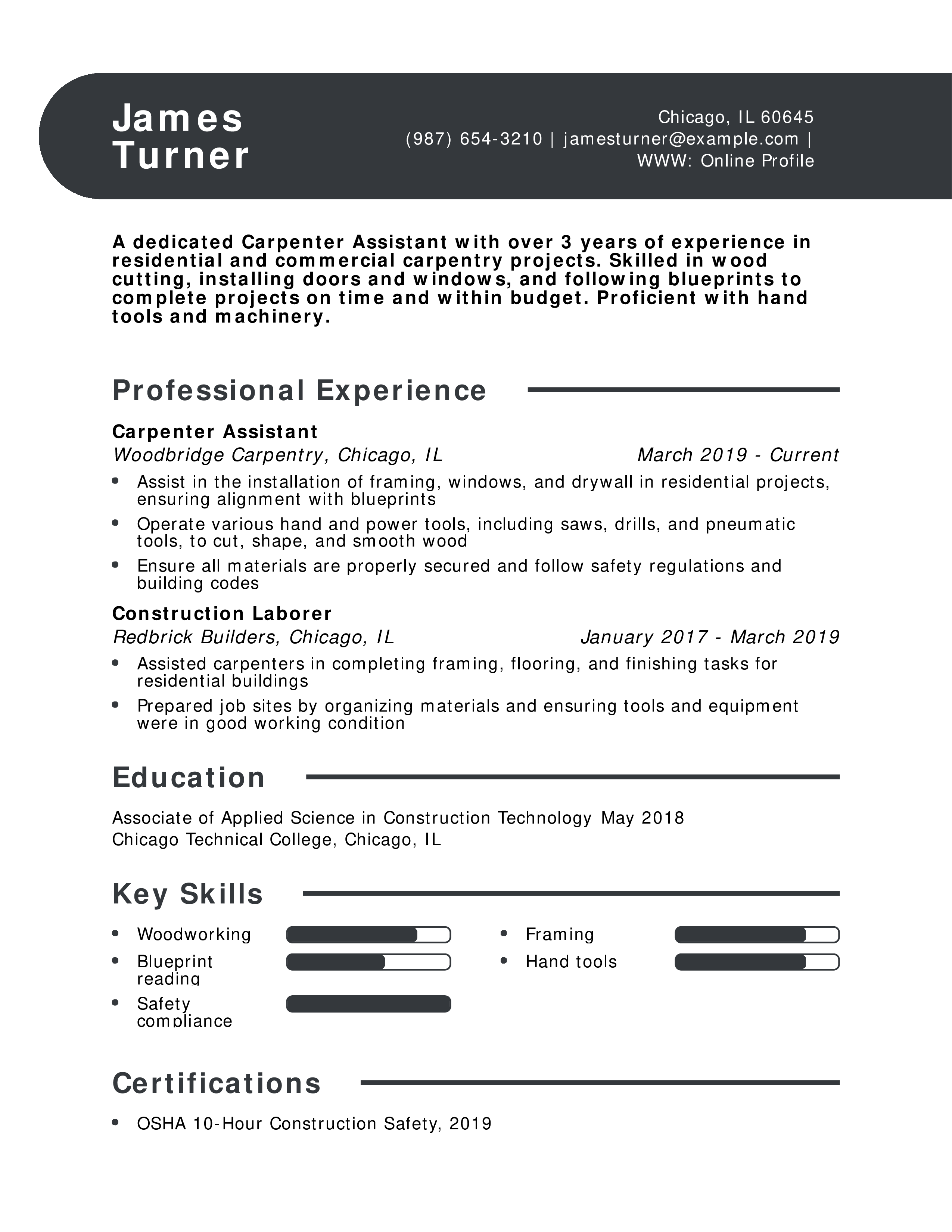
Why This Resume Works
James’ resume emphasizes his experience assisting carpenters on residential projects, highlighting his familiarity with carpentry tools and safety protocols. It also demonstrates growth from a laborer role to a carpenter assistant position. Learn more about how to list your education on a resume.
Self-Employed Carpenter Resume

Why This Resume Works
Darren’s resume effectively highlights his experience as a self-employed carpenter, emphasizing both his craftsmanship and his ability to manage projects from start to finish. It underscores his versatility, working on both custom projects and large-scale home improvements. Learn more about how to list certifications on a resume.
Construction Worker Resume
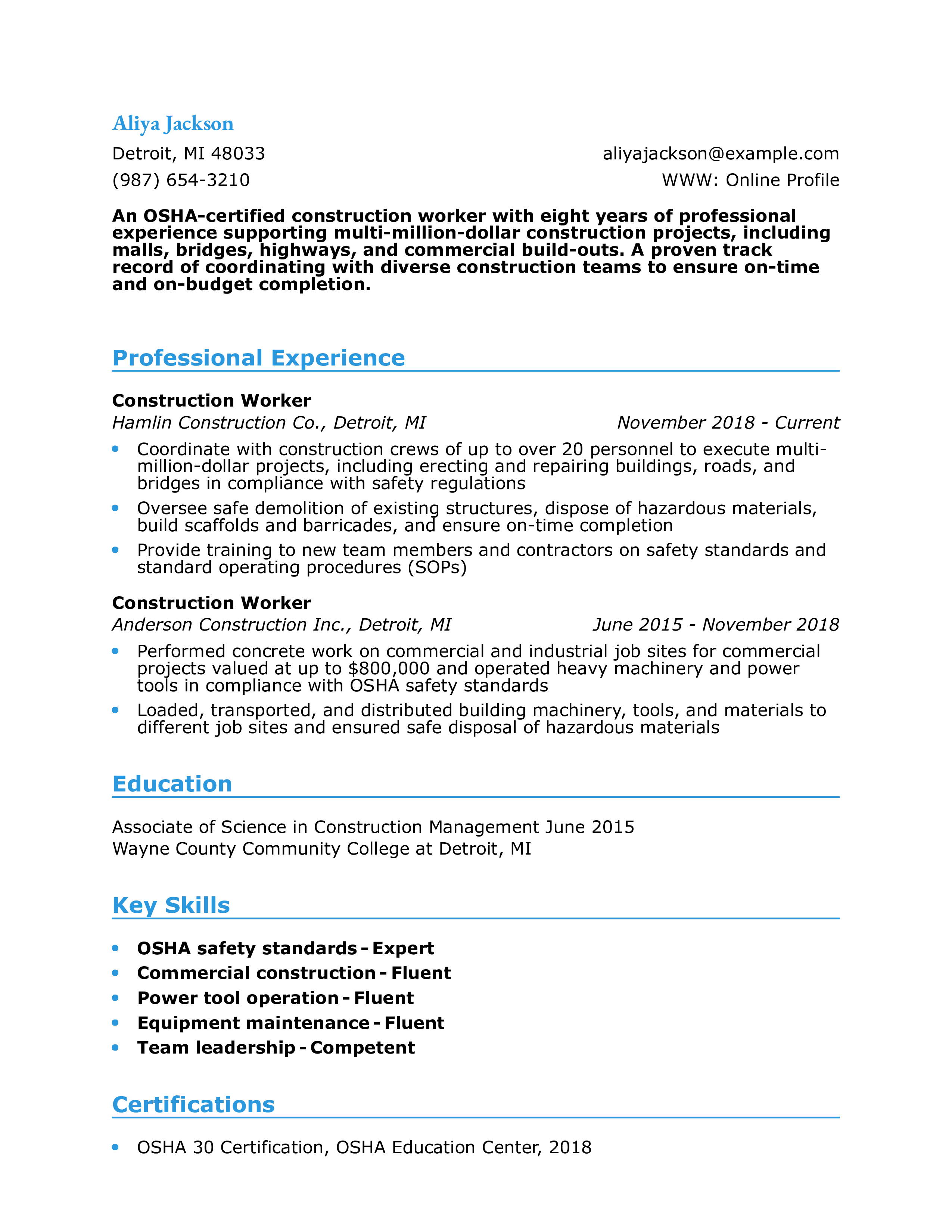
Why This Resume Works
Aliya’s resume focuses on her extensive experience in the construction field, highlighting her ability to manage large projects and ensure compliance with safety standards. It also emphasizes her leadership skills and safety certifications, which are critical in construction roles. Learn how to list your references on a resume.
Carpenter Apprentice Resume
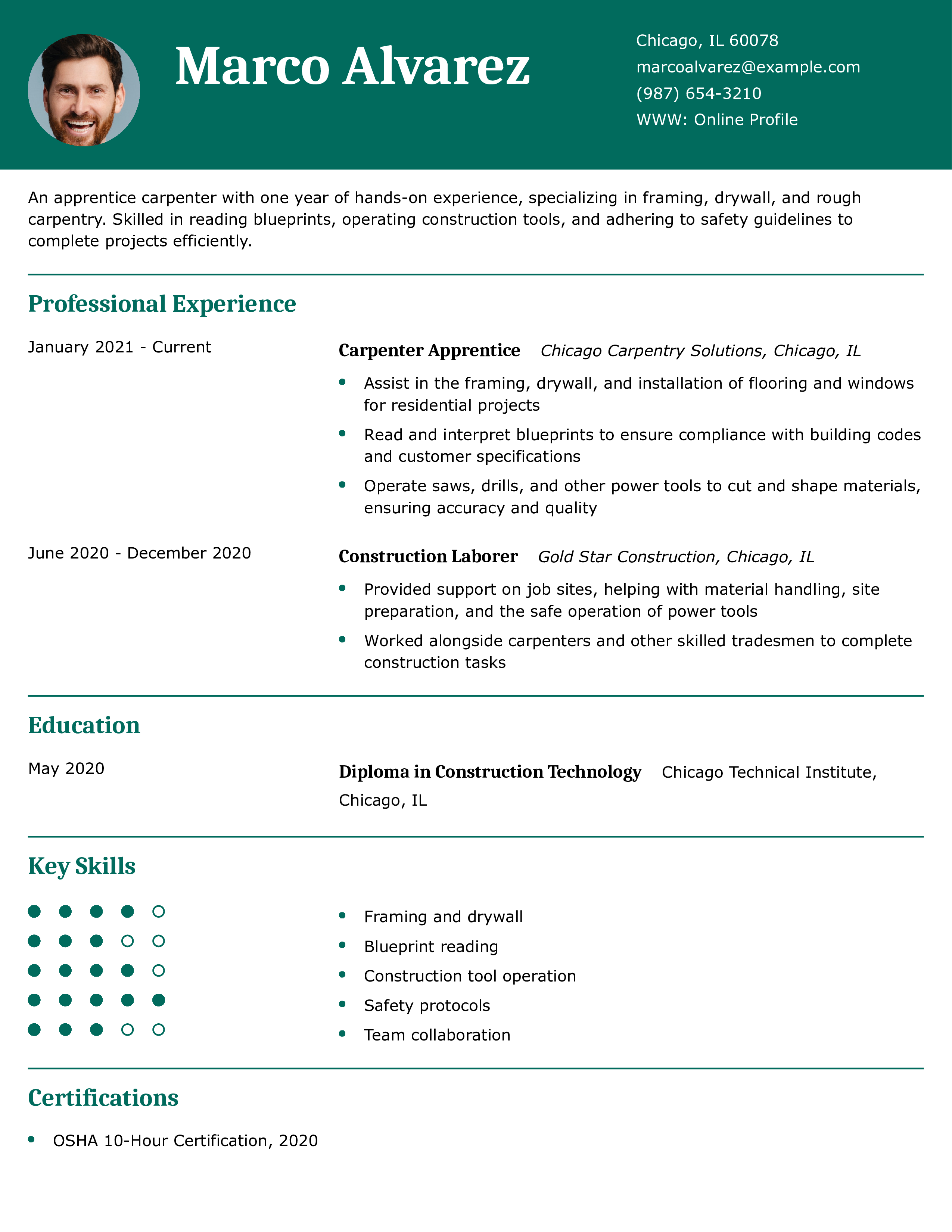
Why This Resume Works
Marco’s resume showcases his apprenticeship experience, which includes hands-on work with framing, drywall, and blueprint reading. It highlights his early career and learning phase, while also demonstrating his commitment to safety. Learn how to list relevant coursework on a resume.
Lead Carpenter Resume
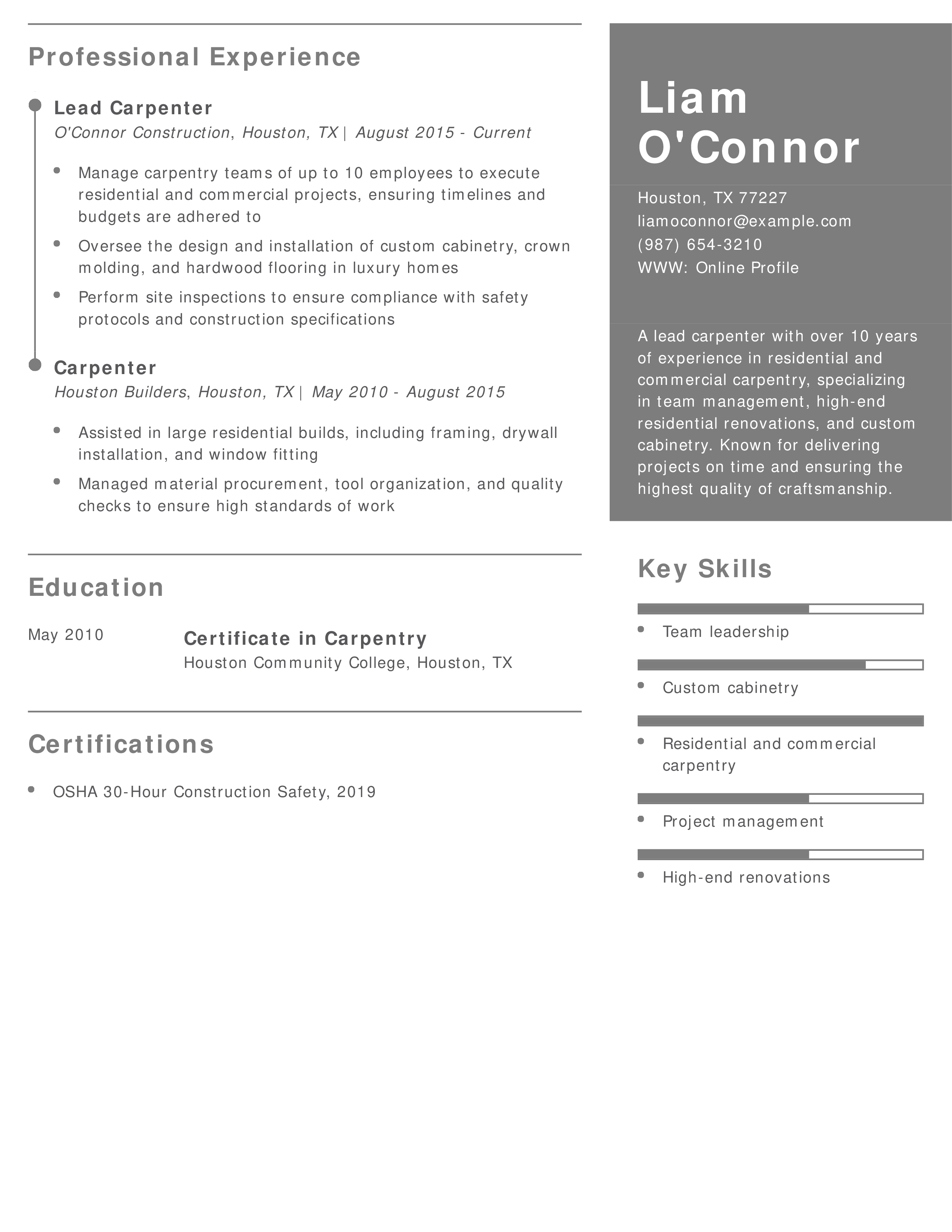
Why This Resume Works
Liam’s resume effectively showcases his leadership skills and experience in custom carpentry, making him a prime candidate for lead carpenter roles. His ability to manage teams and oversee multiple aspects of construction projects demonstrates his depth of experience and leadership abilities. Learn more about what to put on a resume.
Carpentry Supervisor Resume
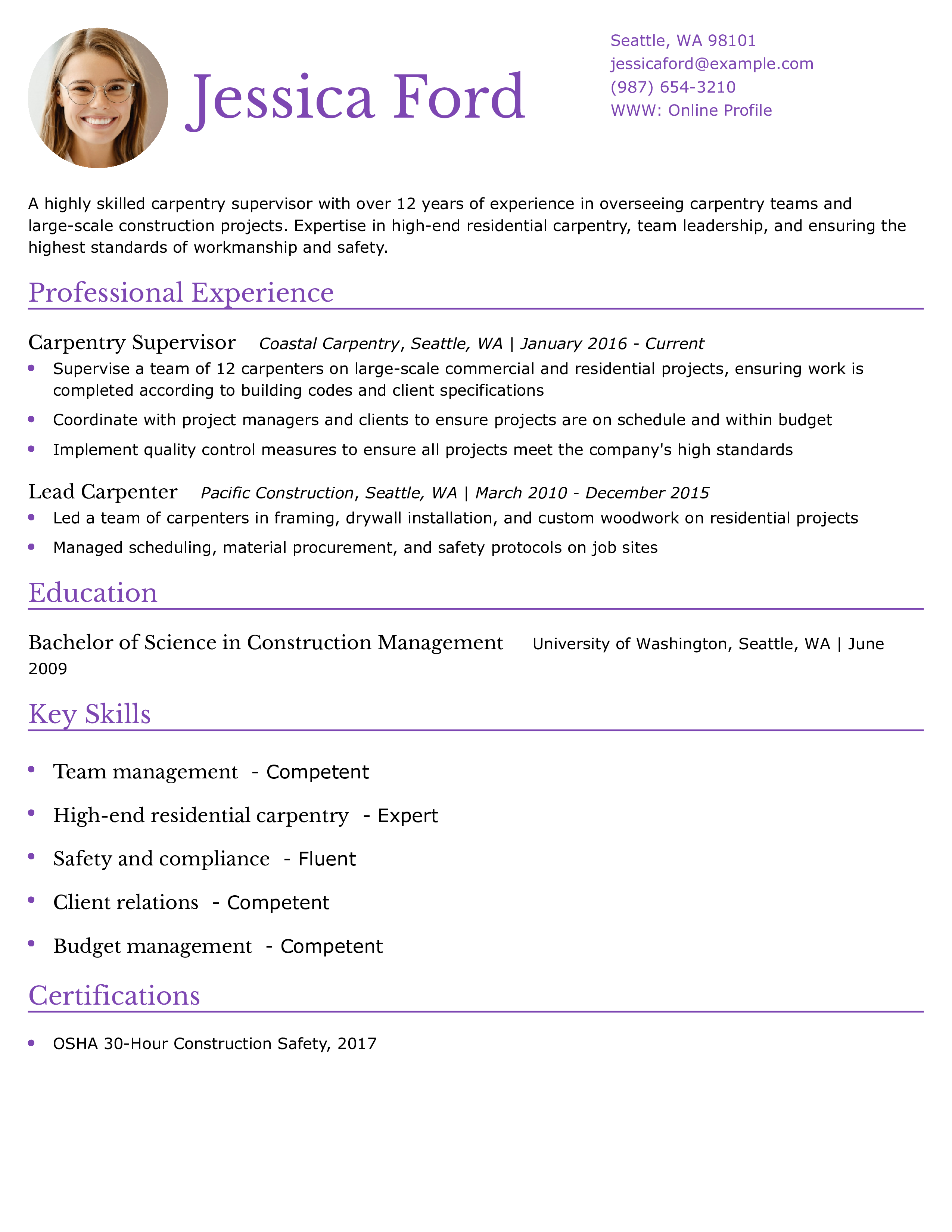
Why This Resume Works
Jessica’s resume highlights her leadership and supervisory experience, making her a strong candidate for senior carpentry roles. The inclusion of her ability to manage teams, schedule projects, and ensure high-quality work is ideal for carpentry supervisor roles. Learn more about how to list certifications on a resume.
Experienced Carpenter Resume
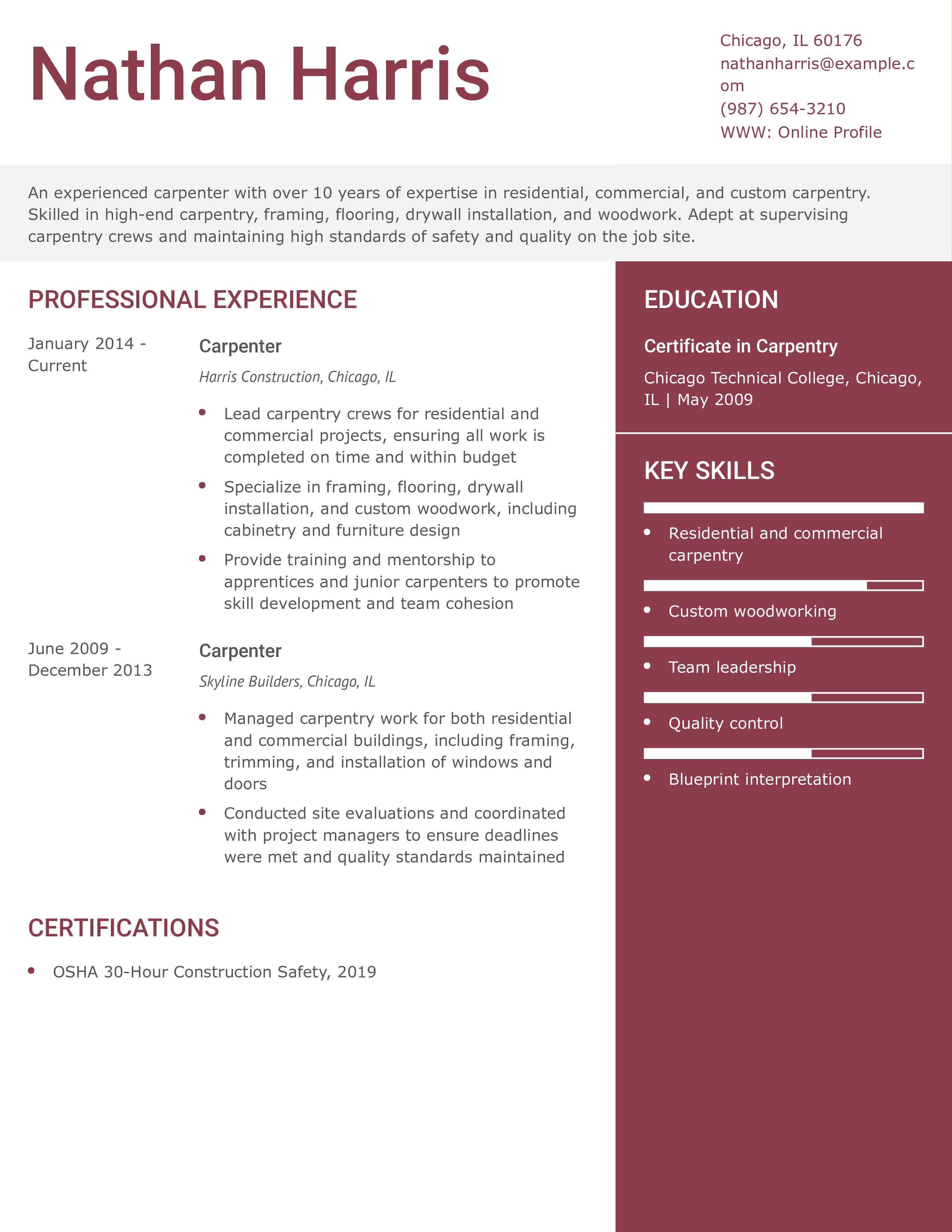
Why This Resume Works
Nathan’s resume emphasizes his diverse carpentry expertise and leadership skills, highlighting his capacity to manage and guide teams on large-scale projects. His ability to handle both residential and commercial projects makes him an ideal candidate for senior carpentry positions. Learn how to list your references on a resume.
Construction Laborer Resume
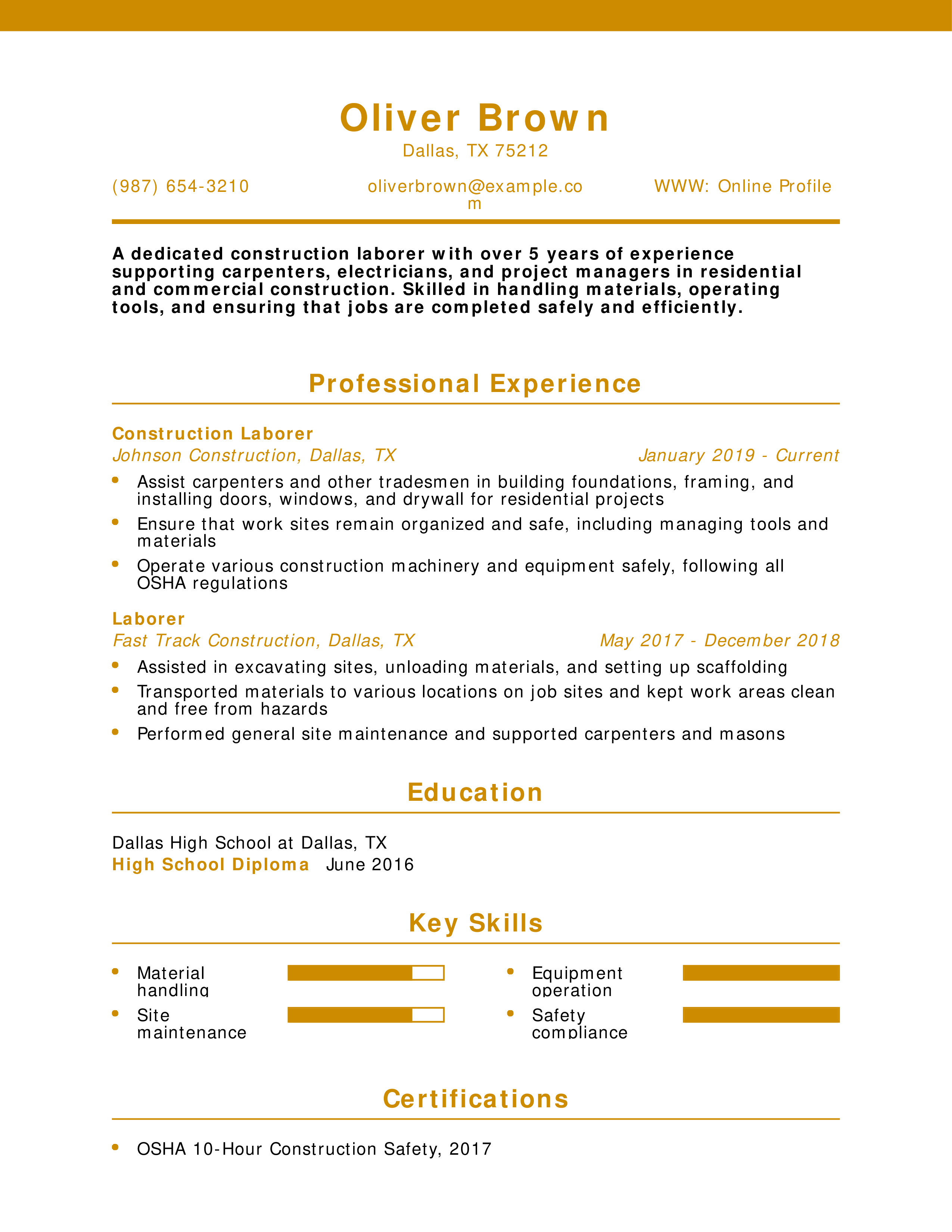
Why This Resume Works
Oliver’s resume highlights the essential skills and tasks that a construction laborer needs to demonstrate. It emphasizes his ability to support various trades and maintain safe work environments, which is crucial for entry-level construction roles. Learn how to put expected graduation date on a resume.
Lead Carpenter Foreman Resume
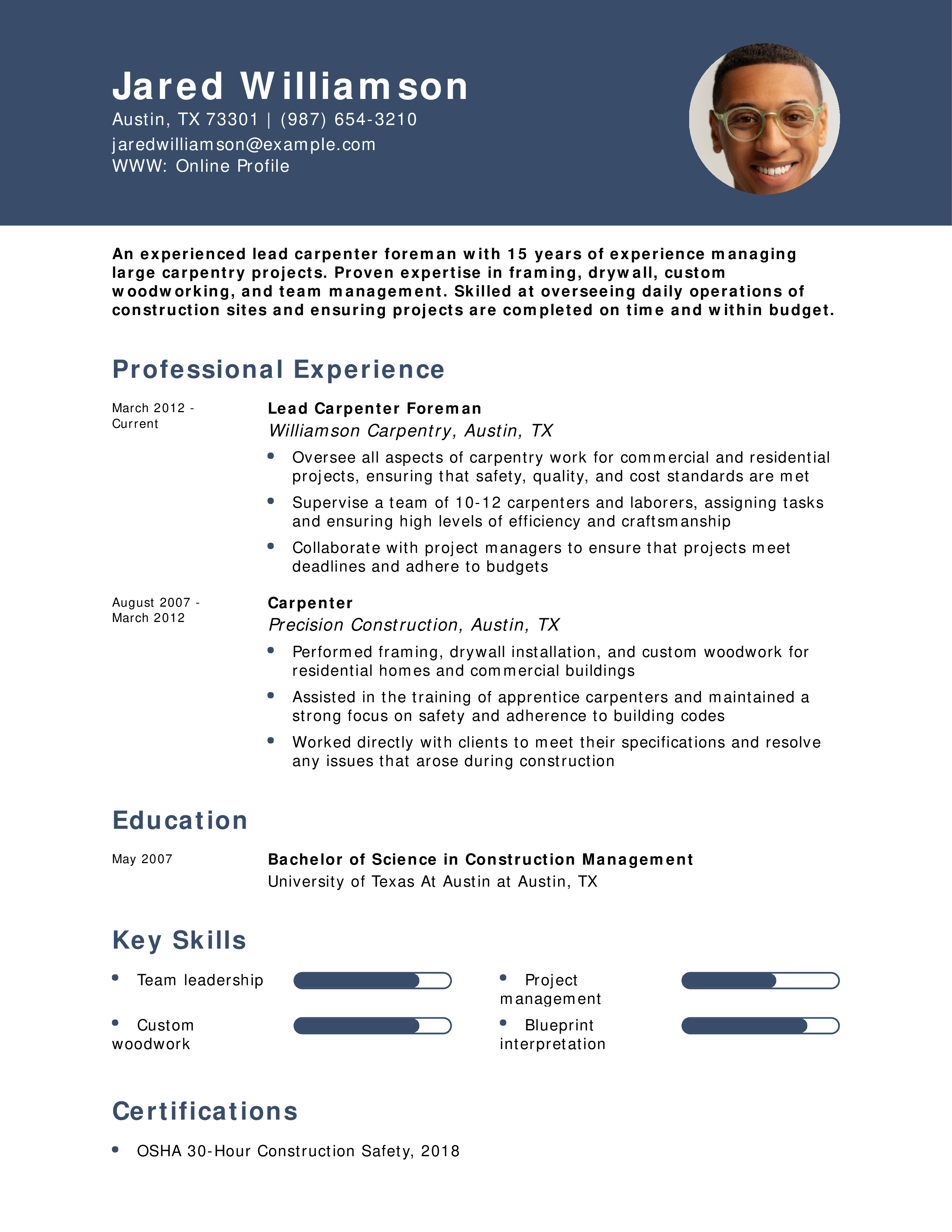
Why This Resume Works
Jared’s resume highlights his leadership capabilities and experience in overseeing carpentry teams and large-scale projects. His ability to manage operations, maintain quality, and meet client expectations positions him as a strong candidate for senior carpentry roles. Learn how to list your education on a resume.
Residential Carpenter Resume
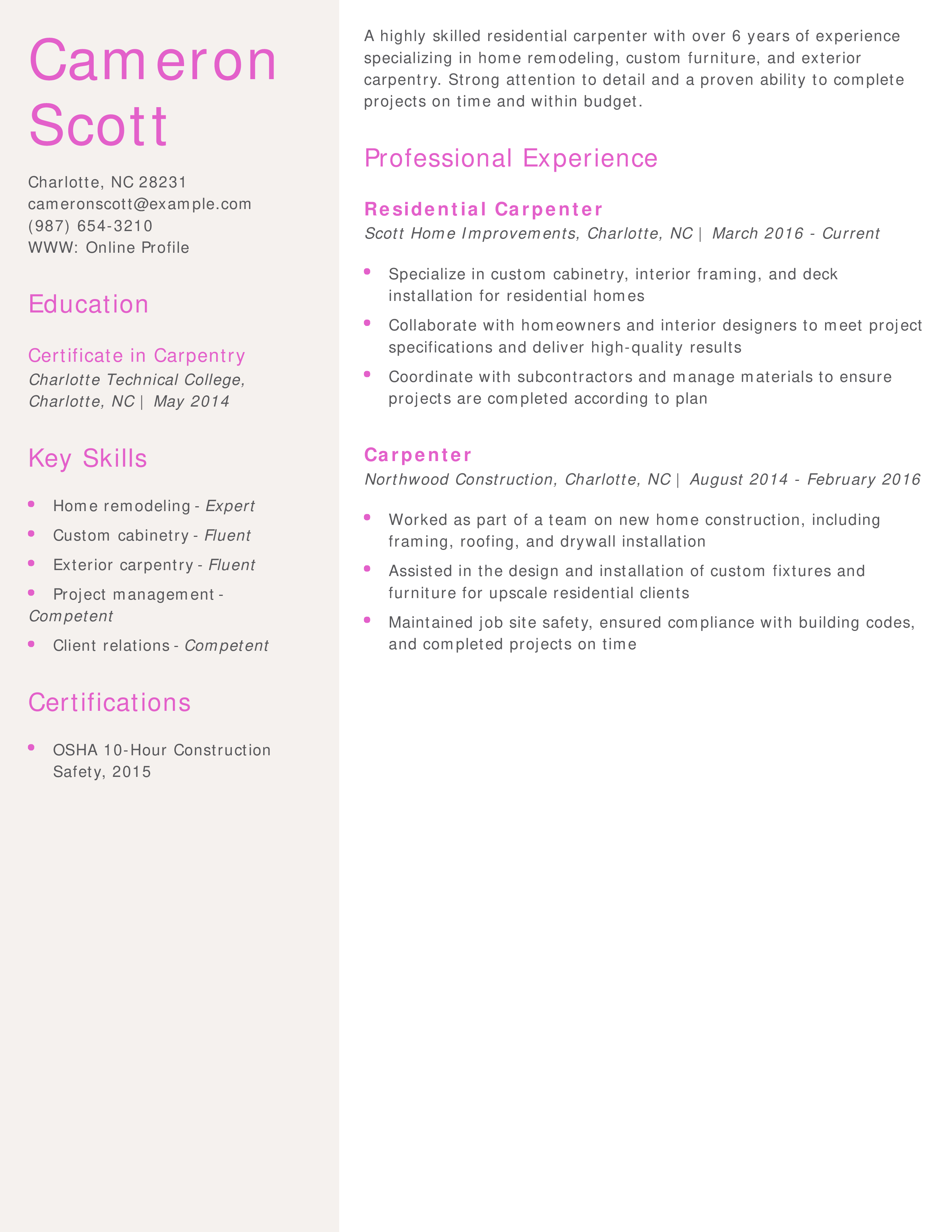
Why This Resume Works
Cameron’s resume highlights his ability to manage both the technical and creative aspects of residential carpentry. His experience with custom work and client interaction, combined with his strong safety certifications, makes him an ideal candidate for a variety of residential projects. Learn more about customer service skills for resumes.
Construction Foreman Resume
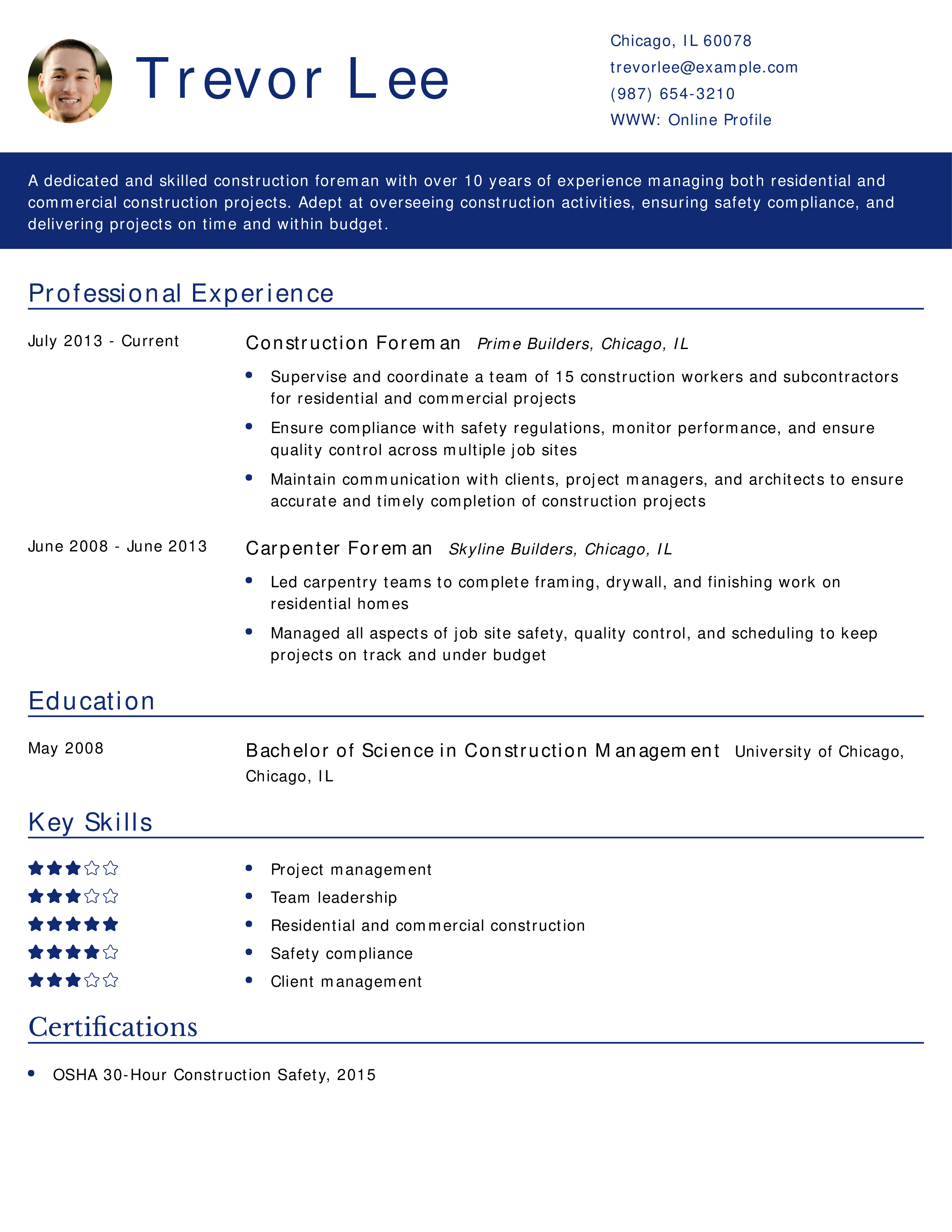
Why This Resume Works
Trevor’s resume emphasizes his ability to manage large teams and oversee complex construction projects while ensuring safety compliance. His leadership and ability to communicate with multiple stakeholders make him a strong candidate for construction foreman roles. Learn more about how to list certifications on a resume.
Heavy Equipment Operator Resume
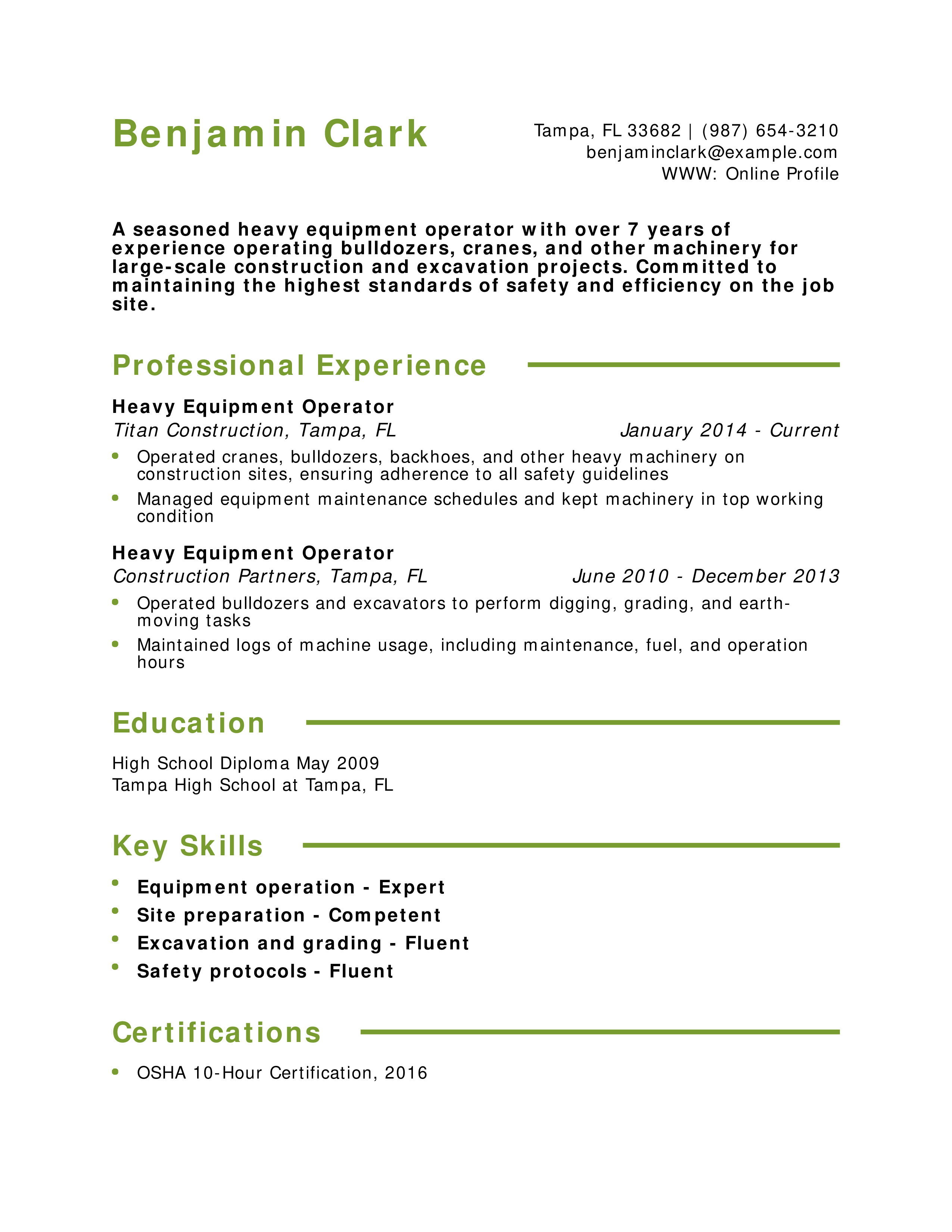
Why This Resume Works
Benjamin’s resume showcases his extensive experience with heavy equipment, along with a strong emphasis on safety compliance and machine maintenance. This combination positions him as an ideal candidate for roles in large-scale construction projects. Learn how to list your education on a resume.
Construction Project Manager Resume
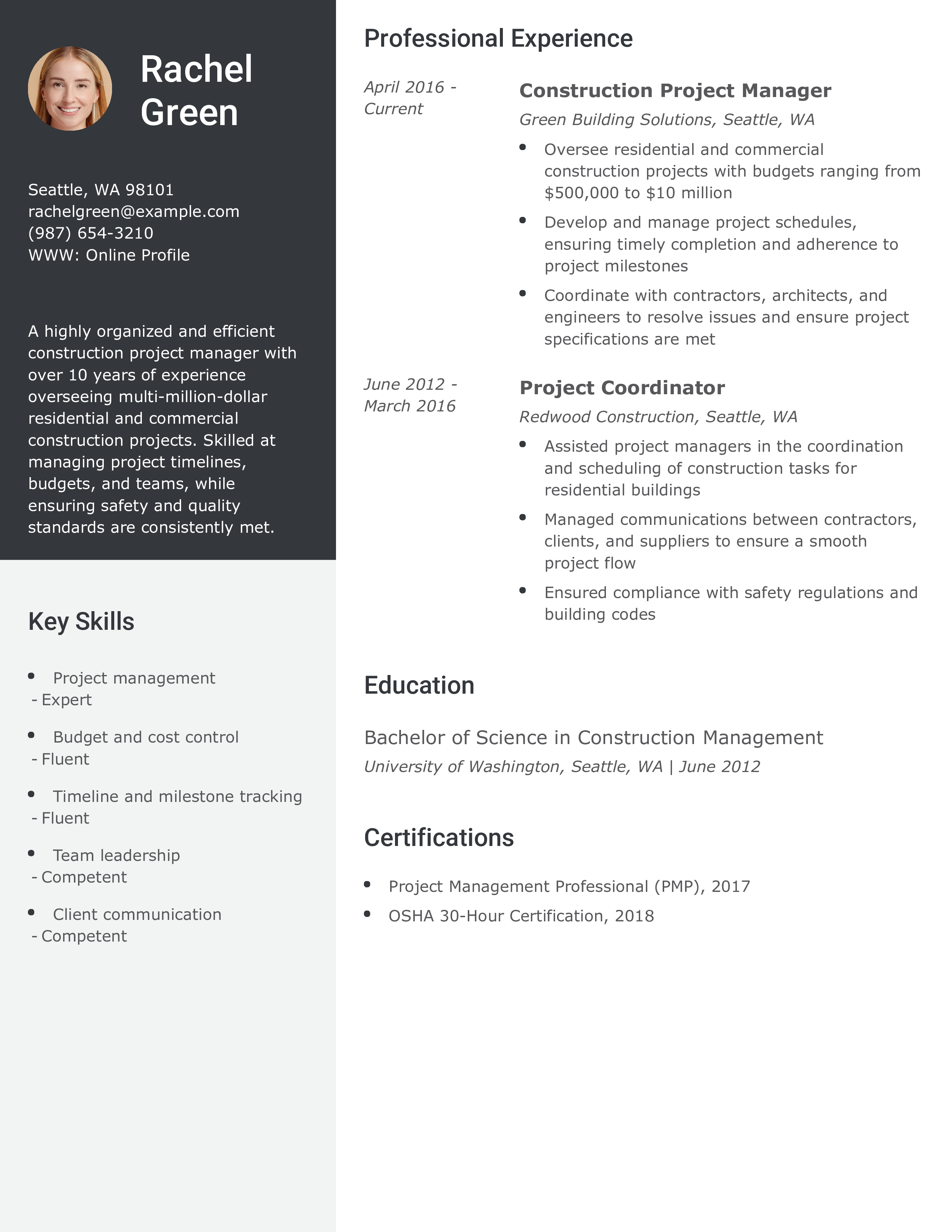
Why This Resume Works
Rachel’s resume effectively demonstrates her leadership and project management skills, with a focus on managing both residential and commercial projects. Her certifications and successful completion of high-budget projects make her a competitive candidate for senior project management roles. Learn how to list certifications on a resume.
Commercial Carpenter Resume
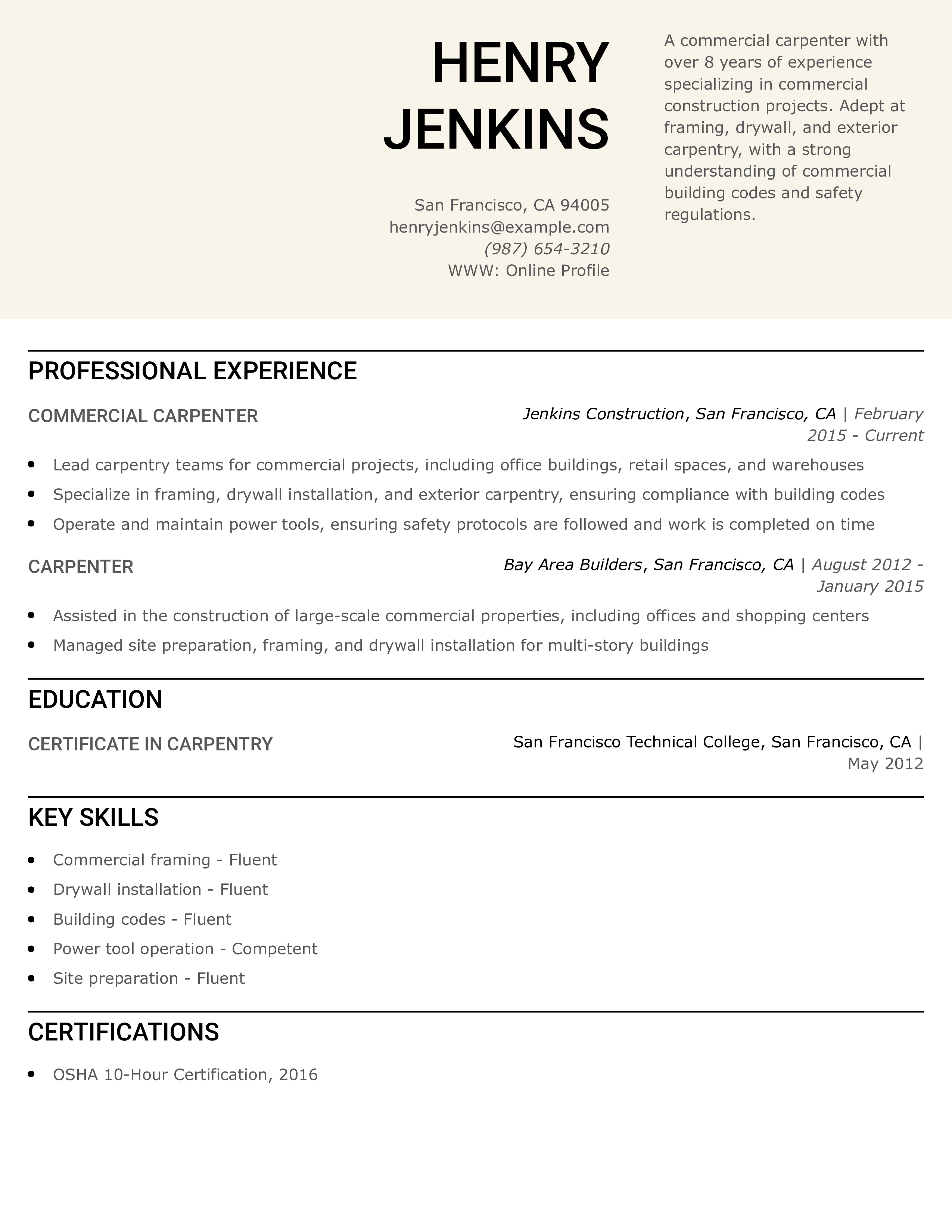
Why This Resume Works
Henry’s resume highlights his extensive experience in commercial carpentry and his ability to manage complex construction projects. His emphasis on safety and compliance with building codes makes him a strong candidate for commercial projects. Learn how to list references on a resume.
Residential Construction Carpenter Resume
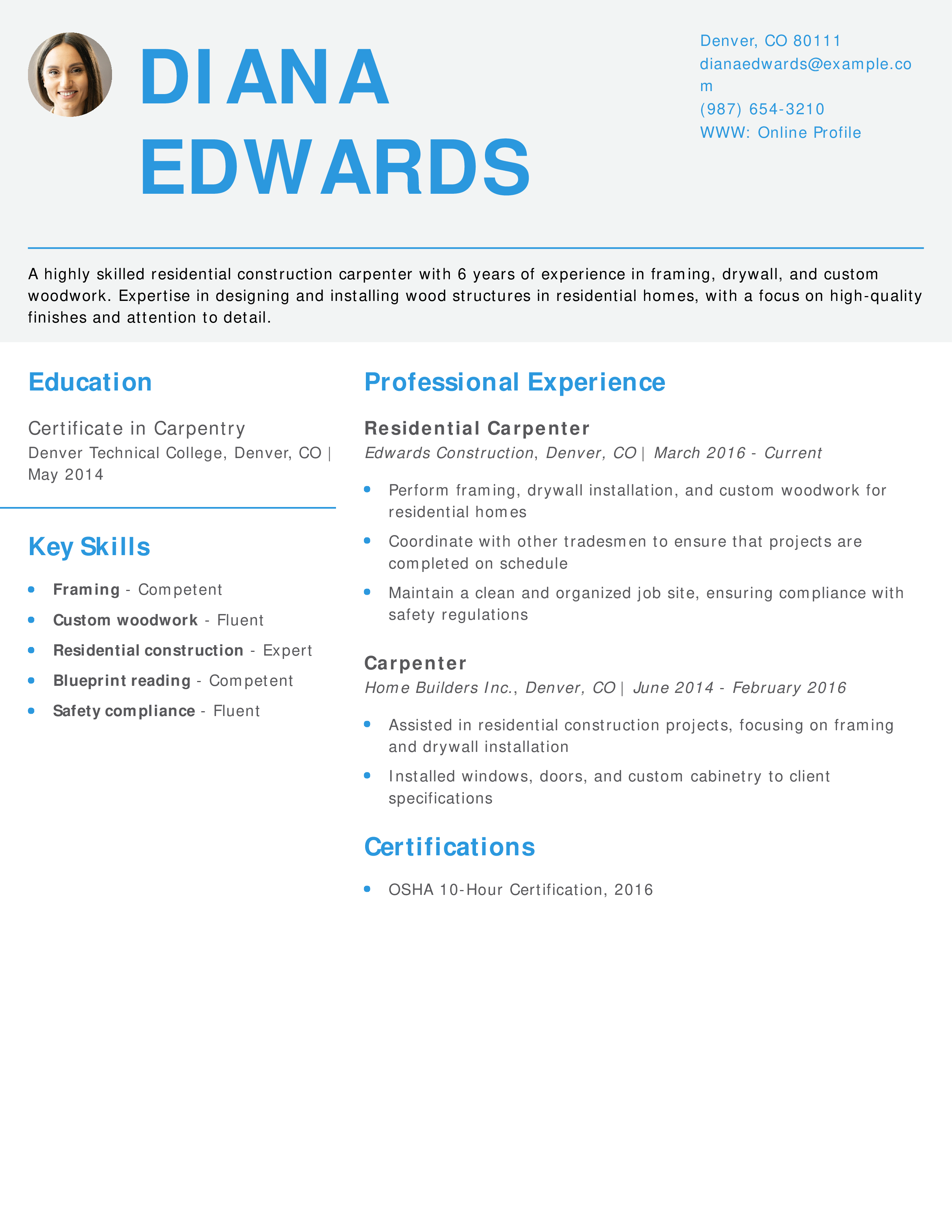
Why This Resume Works
Diana’s resume highlights her skills in residential carpentry, with a focus on framing and custom woodwork. Her experience in both team and solo projects demonstrates her versatility and expertise in residential construction. Learn how to list your education on a resume.
Skilled Carpenter Resume

Why This Resume Works
Lucas’s resume demonstrates his expertise in custom woodwork and cabinetry, key skills for skilled carpenters. His diverse range of residential and commercial carpentry work makes him a versatile candidate. Learn how to put expected graduation date on a resume.
Interior Carpenter Resume
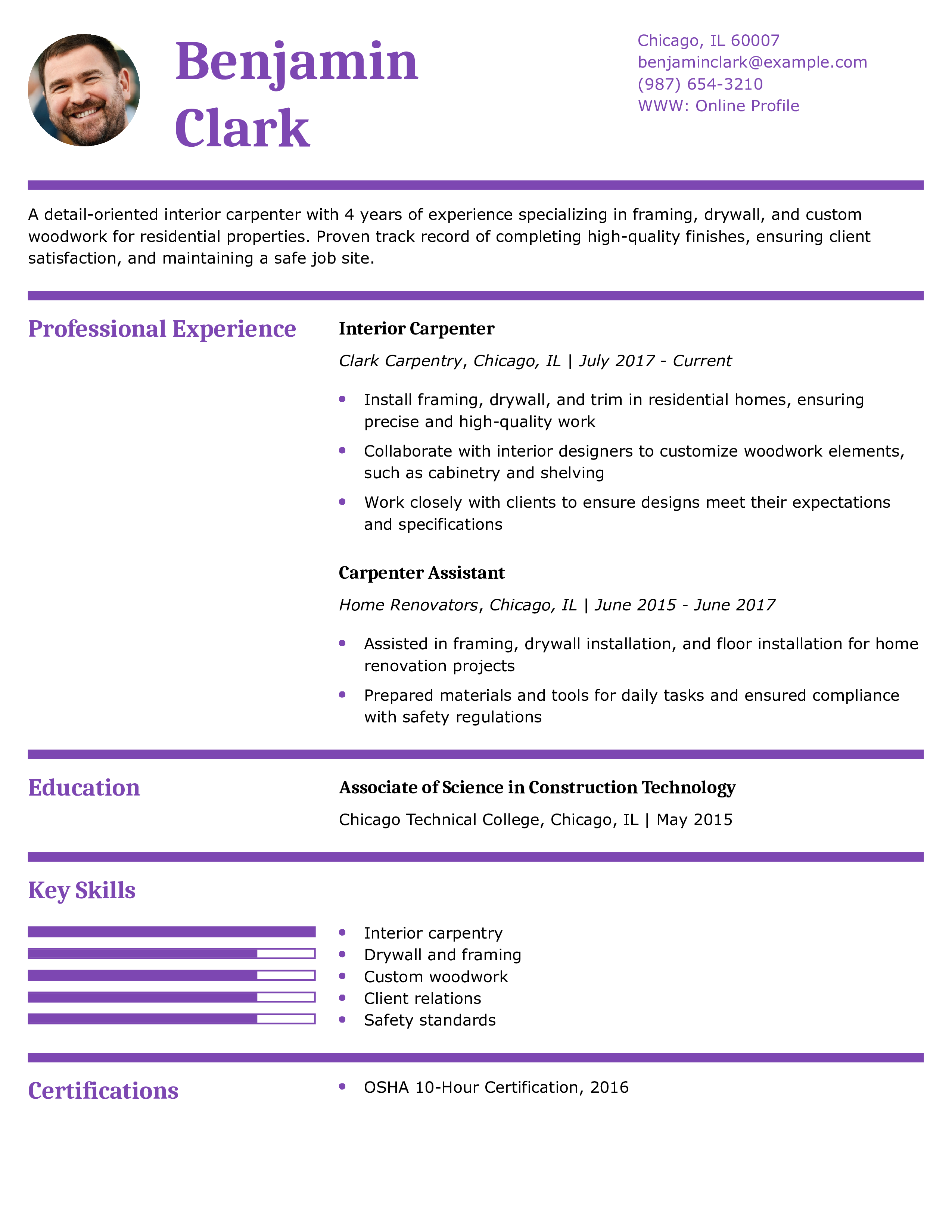
Why This Resume Works
Benjamin’s resume demonstrates his focus on interior carpentry, emphasizing his skills in framing, drywall, and custom woodwork. It highlights his ability to work with clients and interior designers, making him an ideal candidate for interior carpentry roles. Learn how to list certifications on a resume.
Residential Construction Lead Carpenter Resume
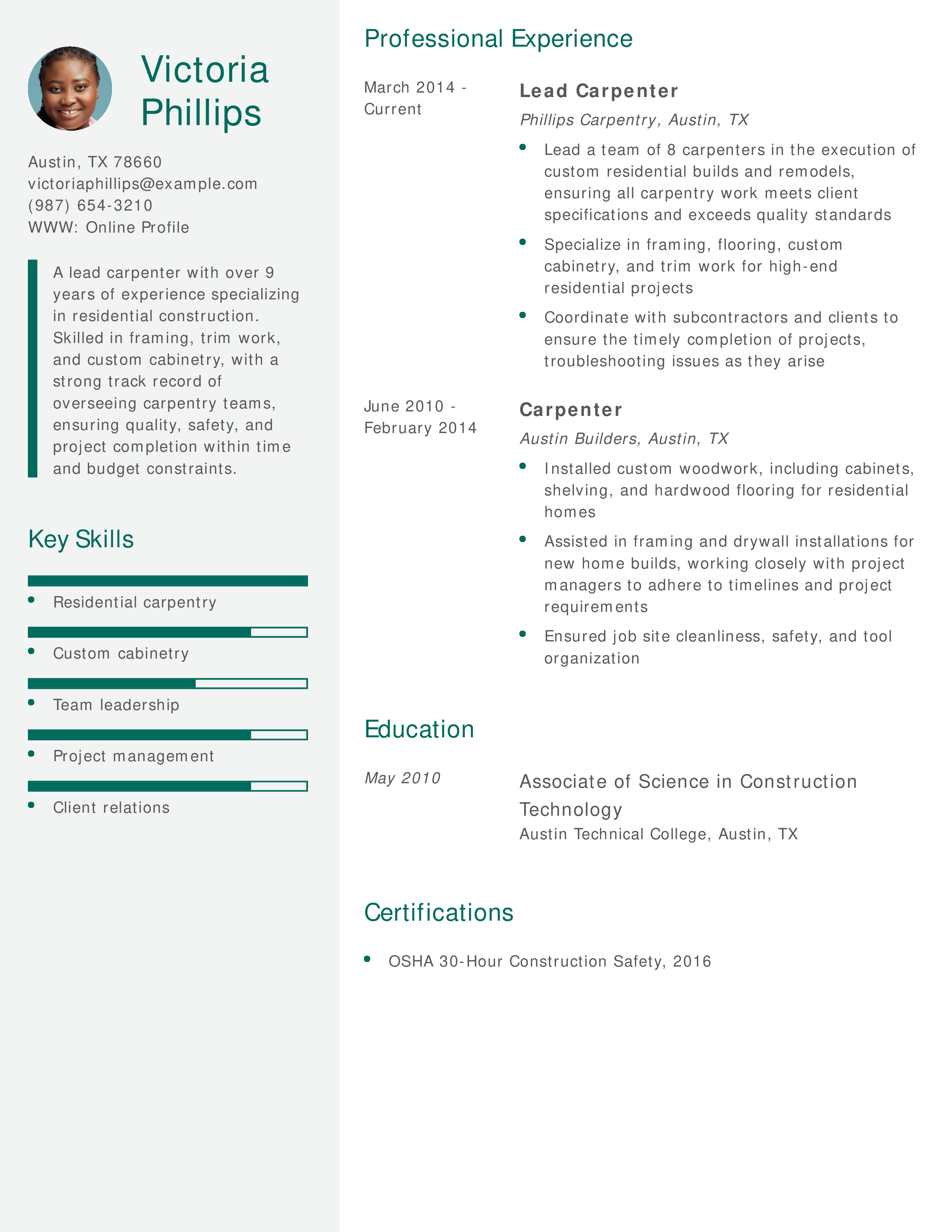
Why This Resume Works
Victoria’s resume highlights her extensive experience in managing carpentry teams, working on high-end residential projects. The combination of hands-on carpentry skills and leadership experience makes her a strong candidate for lead roles. Learn more about resume skills.
Construction Equipment Operator Resume
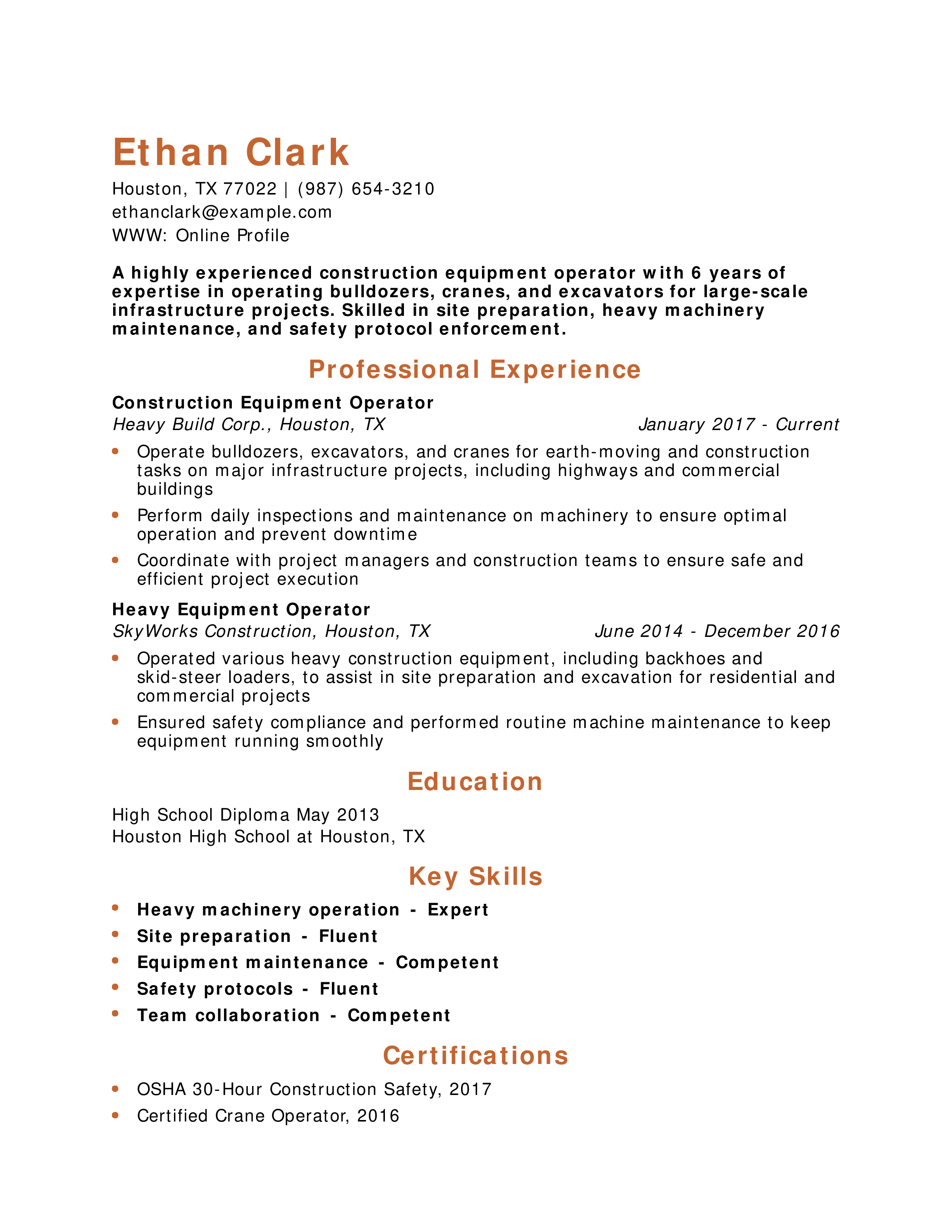
Why This Resume Works
Ethan’s resume focuses on his extensive experience with heavy equipment and his ability to maintain safety and efficiency on construction sites. His certifications and practical skills in equipment operation make him an ideal candidate for heavy machinery operator roles. Learn more about how to email a resume.
Our templates are crafted by professional resume writers to make creating your resume quick, easy, and effective.
- Professional resume template downloads
- Customized cover letter generation
- AI resume writing support
- Career-building resources and advice
Carpenter Text-Only Resume Templates and Examples
How To Write a Carpenter Resume
1. Write a brief summary of your carpenter qualifications
The main goal when writing your resume profile is to create a concise and impactful statement that captures the attention of employers. In two to three sentences, emphasize your professional background and commitment to delivering high-quality artistry. Start by mentioning your years of carpentry experience to demonstrate your expertise and dedication to the craft.
Use industry-specific keywords to highlight your carpentry skills, such as woodworking, framing, and cabinetry. Consider incorporating an impressive stat or achievement to spotlight your exceptional workmanship. For example, you can mention the number of successful projects completed or any awards and certifications earned. Engage potential employers or clients with impressive facts about you, enticing them to continue reading your resume.
Senior-Level Profile Example:
A master carpenter with over 10 years of professional experience managing a wide range of residential and commercial construction projects. A proven track record of developing high-impact safety cultures to prevent workplace injuries. Adept at analyzing complex blueprints and collaborating with client stakeholders.
Entry-Level Profile Example:
An apprentice carpenter with two years of professional experience specializing in drywall installation, blueprint reading, and building codes. Adept at collaborating with diverse construction teams to execute residential and commercial projects.
2. Create a powerful list of your carpenter experiences
Demonstrate your value to potential employers by crafting an accomplishment-driven professional experience section. Use this space to focus on showing your abilities in action. Start by quantifying your experience, such as the size of project budgets you’ve managed, the timelines you’ve worked through, or the scope of projects you’ve worked on. This strategy helps employers gauge the scale of your work and the level of responsibility you’ve handled.
Feature specific accomplishments, such as meeting project deadlines, reducing costs, or receiving recognition for exceptional abilities in the craft. Use action verbs in your writing to describe your achievements and responsibilities, adding a dynamic element to your bullet points. Start each bullet point with an action verb to show your proactive work ethic and highlight the results achieved.
Senior-Level Professional Experience Example:
Master Carpenter Layton Construction, Sandy, UT
October 2015 – present
- Coordinate with construction teams, architects, and project managers to execute multi-million-dollar construction projects for commercial and residential clients
- Execute the $25 million build-out of a housing development with over 55 homes, lead a team of over 20 carpenters, and conduct inspections to ensure compliance with safety and quality standards
- Deliver training on OSHA safety standards and personal protective equipment (PPE) protocols, develop a culture of safety, and successfully reduce workplace accidents by over 30%
Entry-Level Professional Experience Example:
Apprentice Carpenter, Tradesmen International, El Paso, TX
July 2019 – present
- Coordinate with construction teams to execute residential projects valued at $20,000 to $150,000, including floor, drywall, window, and ceiling installations
- Analyze blueprints and technical drawings, inspect buildings to identify damage, defects, and potential hazards, and cut materials to precise specifications
- Utilize scaffolds, ladders, and safety harnesses to complete tasks at tall heights and ensure compliance with PPE protocols and OSHA safety standards
3. Add carpenter education and certifications
Provide employers with a clear understanding of your formal training and qualifications by including an education section. Your academic background shows you’ve acquired the necessary knowledge and skills to excel. Starting with your highest level of education, mention any relevant degree or diploma programs you’ve completed in carpentry, construction management, or a related field. List the degree name, institution, location, and graduation date.
Include any industry certifications or licenses you hold, such as those related to OSHA safety or specific carpentry skills. Create a separate section to showcase these credentials, providing the certificate name, issuing organization, and date obtained.
Education
Template
- [Degree Name]
- [School Name], [City, State Abbreviation] [Dates Enrolled]
Example
- Diploma in Construction Technology (Carpentry)
- Vista College, El Paso, TX, September 2018 – June 2019
Certifications
Template
- [Certification Name], [Awarding Organization], [Completion Year]
Example
- Certified Building Envelope Technician (CBET), Carpenters International Certification Council, June 2018
4. Include a list of skills and proficiencies related to carpenters
A key skills section gives potential employers valuable insight into your abilities and the value you can bring to their projects. When including skills on your resume, focus on those directly aligned with carpentry and construction. Mention your proficiency in woodworking techniques, knowledge of different tools and equipment, and attention to detail. To increase your chances of getting hired, customize your skills section to match the job requirements you are applying for. This will help employers easily recognize your qualifications and assess your suitability for the position. Check out our list of examples below:
| Key Skills and Proficiencies | |
|---|---|
| Blueprint reading | Building codes |
| Carpentry | Commercial construction |
| Construction management | Finish carpentry |
| Flooring installation | Framing |
| Hand tools | Leadership |
| OSHA safety standards | Power tools |
| Project management | Quality control |
| Residential construction | Roofing |
| Team management | Trim carpentry |
| Wood manufacturing | Scheduling |
How To Pick the Best Carpenter Resume Template
Build a solid framework for your resume by choosing the right template for the job. The best resume template for a carpenter is clean, organized, and visually appealing, allowing your professional accomplishments and key skills to stand out. It should provide a clear, logical structure that effectively presents your experience and qualifications. Select a template that aligns with the industry standards and showcases your carpentry expertise. Avoid overly decorative elements that could distract from the content of your resume.
Frequently Asked Questions: Carpenter Resume Examples and Advice
How do I optimize my Carpenter CV to get noticed by hiring managers?-
To optimize your Carpenter CV, begin by showcasing measurable achievements that demonstrate the value you’ve brought to previous employers. Use action verbs and specific examples to highlight your contributions. Incorporating industry-specific keywords, particularly in the skills and professional experience sections, will help your CV stand out, especially with ATS systems.
What are common action verbs for carpenter resumes?-
Using action verbs conveys your ability to execute tasks, demonstrates your expertise in various carpentry techniques, and highlights your value contribution. These words help to create a vivid picture of your capabilities, making for a compelling and memorable resume. Consider using some of the action verbs below on your carpenter resume:
| Action Verbs | |
|---|---|
| Assemble | Budget |
| Build | Cut |
| Design | Estimate |
| Finish | Frame |
| Install | Insulate |
| Manage | Manufacture |
| Measure | Order |
| Panel | Plan |
| Quote | Remodel |
| Solve | Trim |
How do you align your resume with a carpenter job description?-
According to the Bureau of Labor Statistics, employment for carpenters is projected to increase by 2% between 2021 and 2031. Growth at this slower-than-average rate will create more than 20,000 new jobs over the decade. Slow growth means tight competition, so job seekers must create outstanding resumes to land their desired jobs.
Especially if there's a specific job opening you intend to apply for, it's essential to tailor your resume to that particular role. Start by reviewing the job description and identifying the key skills, qualifications, and requirements the employer seeks. Customize your resume by highlighting your relevant experience, accomplishments, and skills that align with the job description. Showcase your expertise in specific carpentry techniques and emphasize how you can contribute to the employer's goals and meet their unique needs.
What is the best carpenter resume format?-
When choosing a resume format for carpenters, the reverse chronological format is often the most effective. This approach highlights your most recent and relevant carpentry roles while illustrating your career progression. Functional resume formats are generally considered to be outdated by most recruiters and hiring managers, as skill-based resumes won’t allow you to detail your achievements properly. Even at the entry level, you’re better off providing well-written bullet points for projects you worked on in your trade school or apprenticeship.
Should my carpenter resume be one or two pages?-
Your carpenter resume should ideally be one page, especially if you have fewer than 10 years of experience. A two-page resume can be effective for seasoned professionals with a longer track record if it highlights accomplishments and skills directly relevant to the job. Every detail should add value and strengthen your candidacy.
Limit your work experience to the past 10 to 15 years, unless earlier positions are highly relevant. Keeping your resume concise and targeted will make a strong and memorable impression on potential employers.
Craft your perfect resume in minutes
Get 2x more interviews with Resume Builder. Access Pro Plan features for a limited time!



